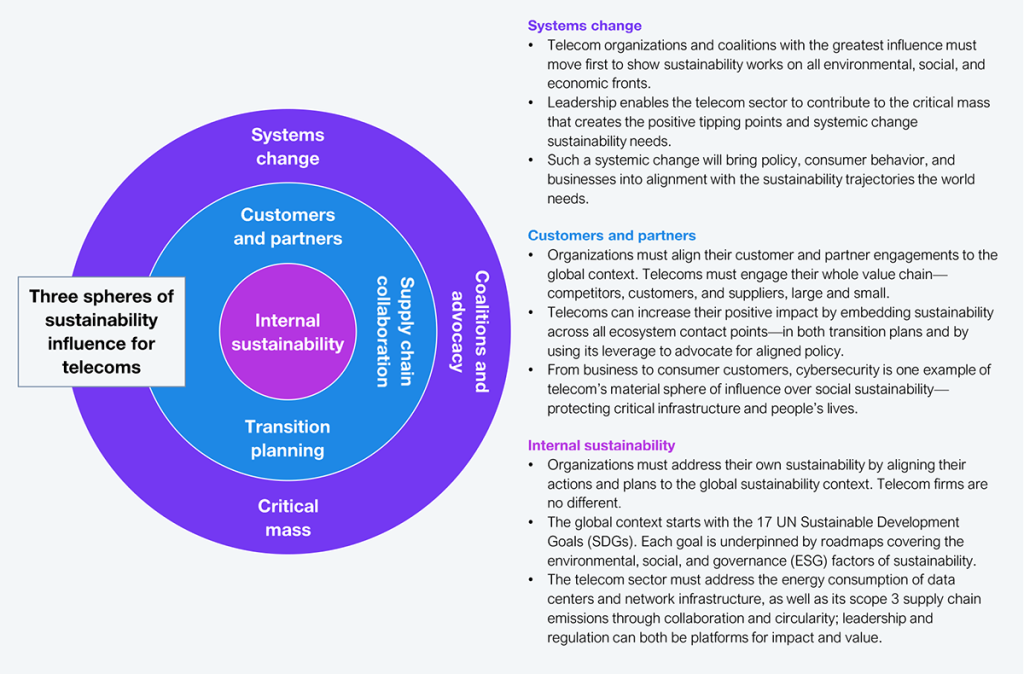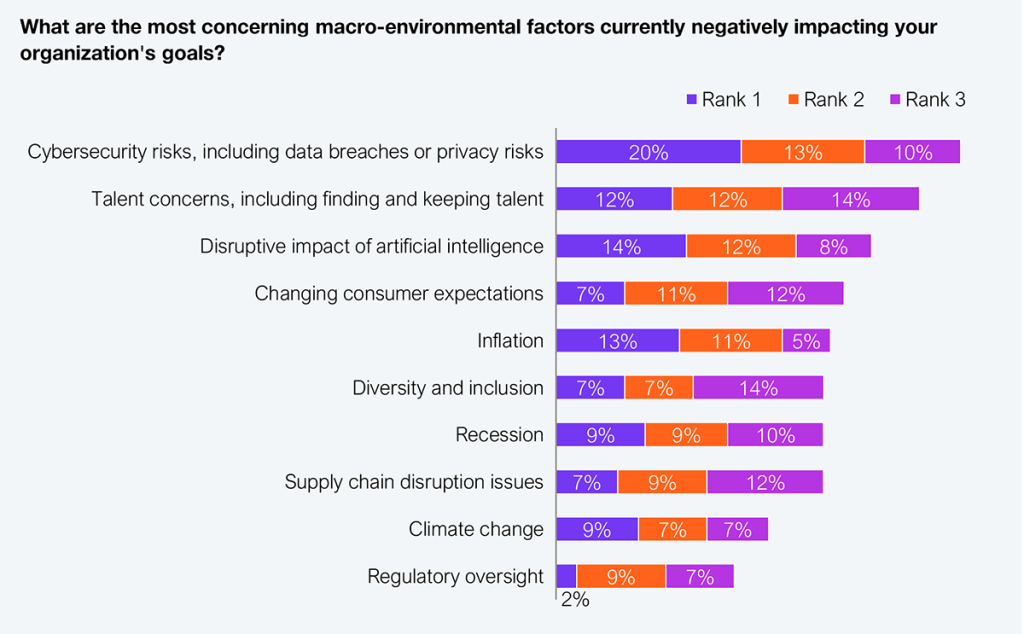Addressing sustainability requires individuals, teams, and whole organizations to effectively analyze how the global context materially impacts their industry, aligning top-level strategy with day-to-day operations. Identifying your most material spheres of influence is vital: internally, with customers and partners, and targeting systems change. Our separate report outlines a guide, while our research framework explores systems change. In the telecoms industry specifically, those spheres of influence are especially clear (see Exhibit 1). To meet the opportunities for positive impact and sustainable business value, telecom firms should focus on energy decarbonization and optimization, supply chain circularity, social impact including cybersecurity, and ecosystem collaboration for the systemic change sustainability needs.
To illustrate the telecom sector’s path to sustainability, we spoke with Will Ennett, head of sustainability and ESG at PXC, a UK telco focused on B2B engagement as a subsidiary of the TalkTalk Group and its broader B2C umbrella.

Source: HFS Research, 2025
TalkTalk Group has aggressively optimized its energy use, reducing its consumption by 30% over the past five years while navigating a 40% increase in bandwidth demand since COVID-19.
Ennett underscores this progress: “We’ve reduced energy consumption by 30%, including by upgrading from copper to fiber networks and optimizing legacy servers.”
Rather than relying solely on government-led grid decarbonization, TalkTalk has focused on direct energy efficiency improvements. While large cloud providers like Microsoft and Google are making strides in building and procuring renewable energy, the telecom sector has a distinct advantage:
“Telecoms is probably in a better position to decarbonize than AI companies—new efficiencies are allowing us to reduce our data center usage and optimize energy-intensive infrastructure rather than increasing that footprint.”
A major telecom challenge is mitigating scope 3 supply chain footprints. The answer partially lies in effectively engaging suppliers to set sustainability goals and track emissions consistently.
TalkTalk has tackled this challenge by collaborating with suppliers to commit to science-based targets and integrating sustainability into its own procurement processes. Ennett explains, “Last year, we made supplier engagement a bonus metric for all relevant employees. We closed the year with 85% of our supply spend going to companies with science-based targets.”
Circularity is another sphere of influence. TalkTalk has prioritized refurbishing routers, saving approximately £10 million annually and significantly reducing emissions.
“Refurbishment is a massive win. It avoids manufacturing new devices and cuts thousands of tons of [CO2 equivalent],” Ennett said.
Challenges remain, however, in obtaining accurate product carbon footprint data from suppliers.
“The level of reporting varies widely,” Ennett noted. “We have to balance setting high standards with ensuring smaller suppliers aren’t excluded.”
Other material sustainability factors, from a social point of view, include cybersecurity (see Exhibit 2). Cybersecurity can negatively impact environmental, social, and economic sustainability elements in several ways:
Cybersecurity threats are an opportunity for telecom companies to minimize harm on behalf of their consumer and business customers. There is also a business case for such a positive customer impact. As service providers, telcos are not directly responsible for instances such as internet harm. But still, they can try to mitigate that harm by expanding a positive sphere of influence, which must be a core mindset for sustainability leadership. For instance, telcos can give consumers more power in terms of how they can use the internet at home. Participating in various industry forums, such as Internet Matters, also enables telcos to help shape the industry’s future and advocate for policy and industry change.

Source: 138 telco, media, and technology executives in our latest HFS Pulse research
TalkTalk plays a key role in uniting telecom providers to drive progress, with Ennett chairing a cross-industry telecom forum representing 80% of the UK market share.
A major outcome of this collaboration was the development of decarbonization guidance for small-medium enterprises (SMEs) in the telecom ecosystem—both SME customers and suppliers. Ennett emphasizes, “Many SMEs lack the resources for sustainability initiatives. Providing them with clear guidance benefits the entire ecosystem.”
Beyond industry cooperation, competitive forces can also drive sustainability advancements. “Collaboration is great, but competition pushes progress, too. No company wants to be left behind,” he said. The balance between these forces ensures continued momentum.
By embedding sustainability into its operations, TalkTalk demonstrates that responsibility aligns with its business outcomes. Ennett notes key takeaways from their approach include:
Looking ahead, TalkTalk aims to refine its carbon accounting methods further, expand its supplier engagement programs, and demonstrate its status as a sustainability leader in the telecoms industry.
“The more we help drive overall change, the more we can achieve our own objectives. Sustainability is a shared responsibility,” Ennett said.
By optimizing energy use, driving supply chain accountability, focusing on social spheres of influence such as cybersecurity, and fostering industry-wide collaboration, TalkTalk proves that sustainability is an environmental, social, ethical, and business imperative—as well as a strategic advantage.
Following TalkTalk’s examples, telecom companies have a clear path: prioritize efficiency, engage supply chains, leverage industry collaboration, and balance competitive incentives with shared goals. Telecom firms that act on this clarity will be best positioned for the future.
Register now for immediate access of HFS' research, data and forward looking trends.
Get StartedIf you don't have an account, Register here |
Register now for immediate access of HFS' research, data and forward looking trends.
Get Started